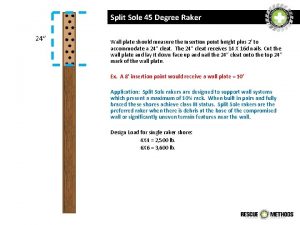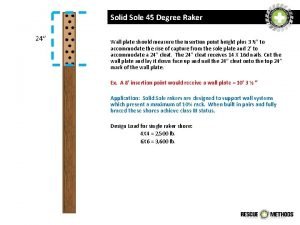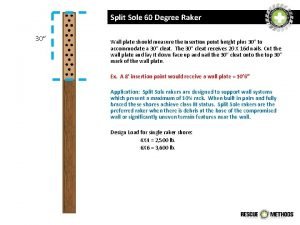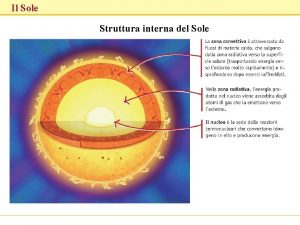Split Sole 45 Degree Raker 24 Wall plate









- Slides: 9

Split Sole 45 Degree Raker 24” Wall plate should measure the insertion point height plus 2’ to accommodate a 24” cleat. The 24” cleat receives 14 X 16 d nails. Cut the wall plate and lay it down face up and nail the 24” cleat onto the top 24” mark of the wall plate. Ex. A 8’ insertion point would receive a wall plate = 10’ Application: Split Sole rakers are designed to support wall systems which present a maximum of 10% rack. When built in pairs and fully braced these shores achieve class III status. Split Sole rakers are the preferred raker when there is debris at the base of the compromised wall or significantly uneven terrain features near the wall. Design Load for single raker shore: 4 X 4 = 2, 500 lb. 6 X 6 = 3, 600 lb.

Split Sole 45 Degree Raker should measure the insertion point height X 17. The raker should receive 45 degree raker cuts with opposing cuts on each end. Ex. A 8’ insertion point would receive a raker = 136” or 11’ 4” Application: This is quickly accomplished by utilizing a speed square for the forty five degree scribe and a 2”X 4” block for the 1 ½” return cut. 136” ***see Solid Sole 60 Degree Raker guide for a general illustration of raker cut layouts with speed squares and 2 x 4’s.

Split Sole 45 Degree Raker Bottom braces x 2 (2 x 6) should measure the same length as the insertion point height. Both ends of the braces are perpendicular cuts. It is important to note that 45 degree rakers have 12/12 ratio of rise to run. 8’ braces may run long and can be trimmed as needed. Ex. A 8’ insertion point would receive 2 Bottom Braces = 8’ each 8’ Application: Cut the sole plate and lay it down face up and pre nail the 24” cleat onto the 8’ mark from the front edge of the sole plate ***When nailing this cleat only drive one nail into the sole plate to temporarily maintain its position. This collection point requires adjustability and cannot be finish nailed until the shore is pressurized.

Split Sole 45 Degree Raker 45 degree Split Sole Rakers require a trough base to anchor the raker. Trough bases are constructed utilizing two 36” 2 x 6’s and one 36” 2 x 4. These are assembled by standing the 2 x 6’s up on their long edge, placing the 2 x 4 flat in between the 2 x 6’s and placing seven 16 d nails into each side. Next, place one 18” 2 x 4 cleat on top of the 2 x 4 base flush with the end of the trough and nail it with five 16 d nails. If raker is to be placed on soil, a 18” square foot will be required under the trough. This is accomplished by placing three 18” 2 x 6’s directly under the trough. 36” 18”

Split Sole 45 Degree Raker Sole Anchors should be engineered when existing anchors are not proximal to desired raker placement or adequate. These anchors are a minimum of 4”X 4’ with 4 – 1”X 36” steel pickets driven at 12” spacing at each raker location. Two pickets may be utilized when driven into concrete or paving material. It may be suitable to run one continuous sole anchor to accommodate multiple rakers. 6 x 6 sole anchors will provide greater strength and stability. Ex. A 16’ X 4” could be utilized to accommodate a three rakers at 6’ spacing between rakers. Application: Measure the distance on the ground that correlates to the collection point or insertion point. Add 18” for the back half of the trough base, 3 ½” for the wall plate and 3 ½” for 4 X 4 wedges or 1 ½” for 2 x 4 wedges. Total additional distance is 23” if using 2 x 4 wedges and 25” if using 4 x 4 wedges. This sum results in the distance from the wall at which the sole anchor should be placed. This should be built while the raker shore is being constructed. This diagram represents a bird’s eye view. Drilling holes for the pins results in greater assurance that the pins will be driven plumb. Ex. An 8’ insertion point and bottom braces would result in a sole anchor placed at 9’ 11” for 2 x 4 wedges or 10’ 1” for 4 x 4 wedges. An easier general rule of thumb is to always add two feet.

Split Sole 45 Degree Raker Place the raker against the wall plate and insure that the raker cut marries well with the cleat. Capture the wall plate joint by completely covering the joint with a 12 X 12 gusset and placing 8 X 8 d nails into the wall plate and 5 X 8 d nails into the raker. Bottom 2 x 6 brace should be placed a minimum of 6” up from the bottom of the wall plate. This will accommodate the trough height. Insure that the brace is square to the wall plate. To insure that the raker angle is maintained, pull a measurement from the interior edge of the wall plate to the point of the bottom raker cut and the result should be the same as the insertion point. Place one 16 d nail into the raker joint and five 16 d nails into the wall plate joint. The single nail will allow for quick adjustability when the raker is placed and pressurized. Upon completion, carefully flip the shore over onto the other side and duplicate the entire process. 8’ *** This diagram also depicts the 12/12 rise to run ratio of a 45 degree raker and how that correlates to the cleat placement or collection points on the wall plate and bottom brace. Min 6”’ 8’

Split Sole 45 Degree Raker When placing the raker, insure that the raker is plumb or square to the building and sole anchor. Set the trough base, walk the assembled raker into place and set it into the trough base. Place 2 x 4 or 4 x 4 wedge packs between the sole anchor and the trough base. While placing the raker, the top of the wall plate will contact the wall but leave a growing gap towards the bottom of the wall. When this is encountered, Remove the single 16 d nail in the bottom brace raker joint. This allows the wall plate to “flex” into position. Pressurize the wedges until the entire wall plate contacts the wall. At that point, finish nailing the bottom brace raker joint and complete pressurizing. The shore should only be pressurized until it is snug. Do not overpressurize.

Split Sole 45 Degree Raker To complete this shore, place pins on both sides of the trough at the front and back to eliminate lateral movement of the trough base. Place five 16 d nails through the trough base sides into the base of the raker. If the bottom 2 x 6 cross brace exceeds 7’ in length, a midpoint 4 x 4 block should be placed between the bottom braces and nailed with five 16 d nails. If the raker is on soil, place the 18” square foot under the trough base. To convert this shore into a class III shore, build it in pairs and apply cross bracing and diagonal bracing. Refer to bracing rules in the 45 degree solid sole raker diagrams. Any raker length greater than 11’ requires midpoint 2 x 6 bracing as well with five 16 d nails in each joint. Insure that bracing elements do not extend past the back edge of the wall plate. The wall plate alone should make contact with the wall.

Split Sole 45 Degree Raker Prior to final pressurization the wall plate should be pinned to the wall to insure that the shore does not “walk up” the wall. This is accomplished with 2 – ½” X 8” wall anchors. Other variables exist that should be referenced in the FOG or SOG Manual.















